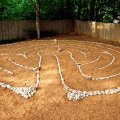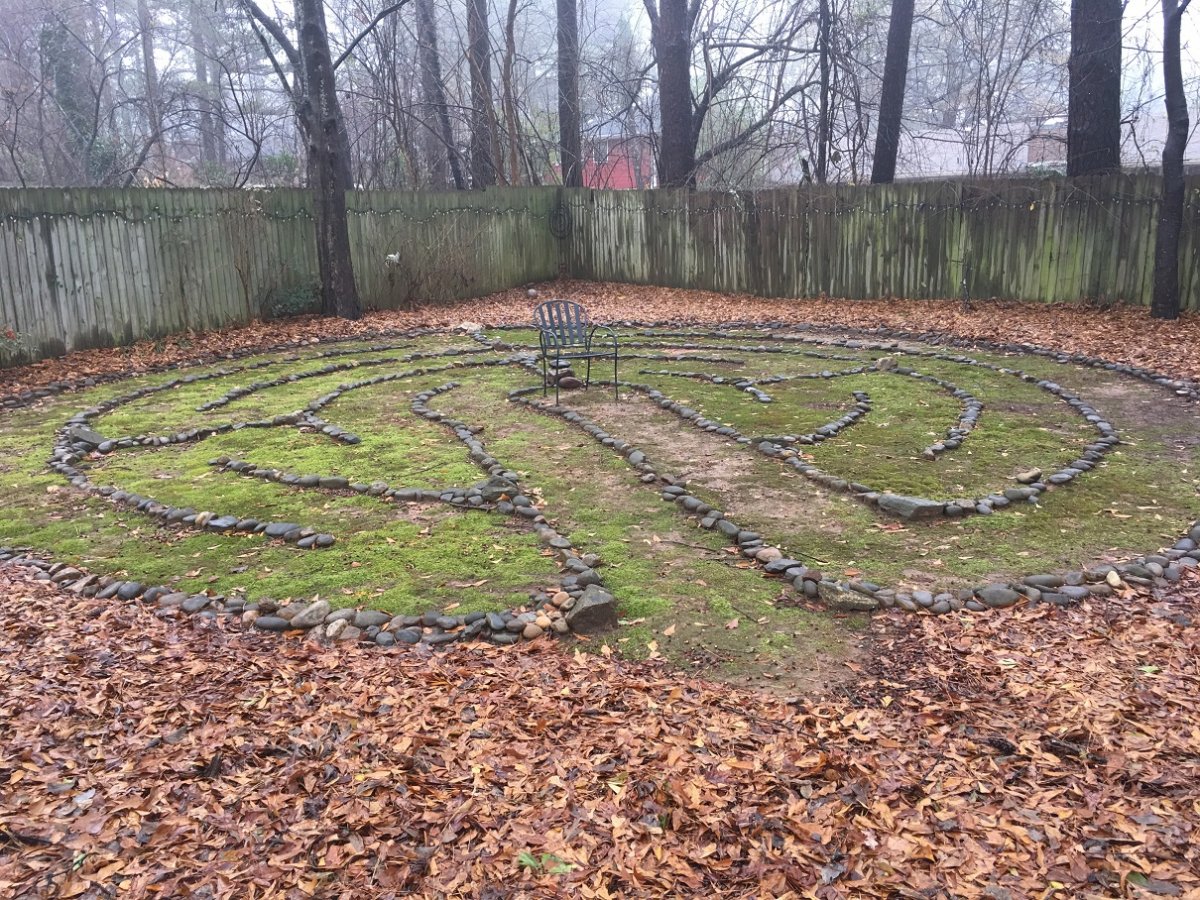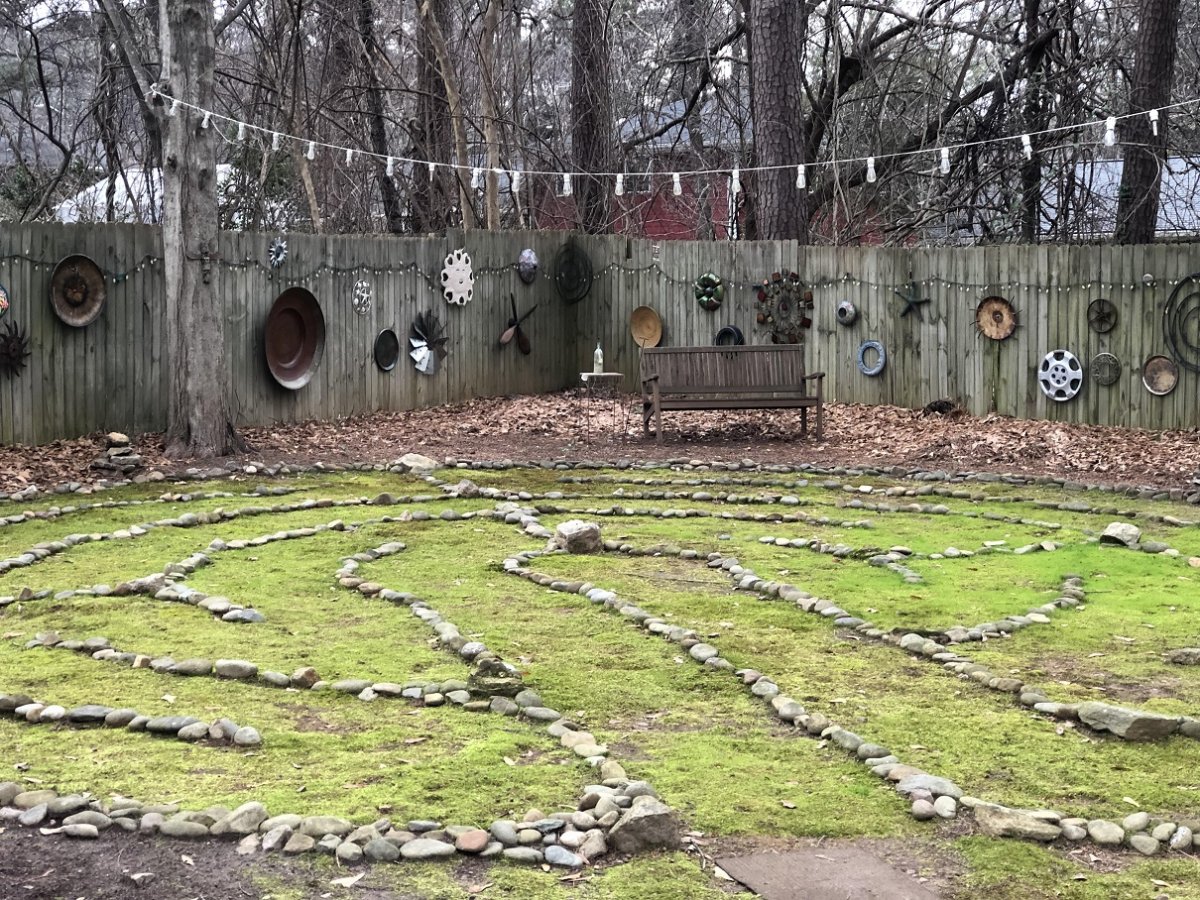The Vistadale Labyrinth
 Behind my office is a 35 foot secluded and peaceful outdoor walking labyrinth.
Behind my office is a 35 foot secluded and peaceful outdoor walking labyrinth.
The labyrinth, an ancient symbol used in many cultures, combines elements of the circle and the spiral to create a meandering but purposeful path that can represent many of the journeys of life.
Walking a labyrinth can center your spirit, balance your emotions, enhance your intuition and help you to experience what's going on inside and around you in a more meaningful way.
Unlike a maze, a labyrinth has no dead ends or blind alleys. One path leads from the entrance to the center and back again. As you quietly walk the labyrinth, notice how you relate to each part of the experience.
Two books that are useful for enhancing the labyrinth experience are:
Exploring The Labyrinth: A Guide To Healing And Spiritual Growth
Here's a picture from a few years later as moss started growing inside the labyrinth:

It can be useful before or after a counseling session to spend a few minutes walking the labyrinth in any way that seems valuable to you. It's also helpful to spend some time writing or simply sitting on a bench and reflecting on what we talked about. This will help the positive effects of our counseling session extend well past the 50 minutes we are together.
By the way, here's more recent photo that shows how the labyrinth has evolved over last 12 years:

-
Here's a blog post I wrote a few years back, which I've moved to this page:
Are You Walking a Maze or a Labyrinth?
On the grounds of my Atlanta psychotherapy and counseling office is a secluded walking labyrinth. Many people find that walking a labyrinth before or after a counseling session can be a helpful way to reflect and meditate upon important insights and emerging emotions.
Some people mistakenly think that a labyrinth is the same as a maze, but there are important differences between them. A person walking a maze faces many choices about which direction to take. However, a labyrinth has only one continuous path from start to finish. When you walk a maze you will come to dead ends or repeatedly travel across some of the same terrain as you try to find your way. A labyrinth, however, always leads steadily toward the goal. While it's possible to lose your way in a maze to the point that you have no idea where you are, a labyrinth is specifically designed to guide your journey. All you have to do is put one foot in front of the other and trust the process.
Sometimes life is like a maze while at other times it resembles a labyrinth. Both offer unique learning opportunities to the person walking their winding paths. It helps to know which one you are on at any given moment and how to travel forward when you are faced with difficult choices.
Everyone knows what it's like to face uncertainty in which it isn't clear which way to go. We've all experienced the sensation of going over the same territory when we thought we were moving forward. Losing the way is easy, and it can even be fun if you're just exploring. As the saying goes, “not all who wander are lost.”
But if you are trying to get somewhere in your life, repeatedly going over the same old ground can be discouraging and even dangerous. This is the risk of the maze: it confuses and bewilders. In fact, the word itself stems from the original meaning of the word "amaze", which meant "daze" or "stun".
By contrast, most of us can look back over our lives and identify times when it seemed like we were somehow being guided exactly the way we needed to go. Despite all the twists and turns of the journey there are moments in which we have little doubt about the way forward. At such times the journey seems less like a maze and more like a labyrinth.
One primary way to navigate the "maze" of life and even transform it into a labyrinth is by following conscious principles for living. This is a spiritual task in the broadest sense of purposely investing a sense of meaning into the fabric of the material world. One result of living a principled life is that no matter what confusing challenge is encountered the right route ultimately reveals itself. Even when the choice initially seems uncertain, a clear path will almost always emerge.
Here's an example: since I counsel many people who have lost their way in the maze of addictive desire, I know that 12-step groups offer a set of tested principles that can cut through much of the uncertainty that comes when faced with difficult choices. Many of the core 12-step principles are simple to express even if they are not always easy to follow. They include admitting that you need help, honestly revealing your true self to another person; addressing any harms you've caused others, deep self-examination, and connecting with others who have similar problems. These and other 12-step principles are powerful tools for addressing all types of issues that arise in life.
Of course there are many other ways to stay on the right course toward your goal. However, this doesn't mean that it is always better to know which way to go. Sometimes the belief that we always need to know what to do can prevent the discovery of new possibilities that only become evident when we free ourselves from the desire to be anywhere other than where we are at this very moment.
When you feel lost or confused it's a good idea to slow down, keep your wits about you and ask for help whenever you can. You may not be as far off course as you think. Go slower to get there faster. There is always a way forward. Regardless of whether you are walking a maze or labyrinth, remember that sometimes when you seem to be moving way from your goal you are actually getting closer, for there is rarely such a thing as a straight line in this adventure called life.
------------
Return to my home page or contact me if you'd like to schedule an appointment with me.

